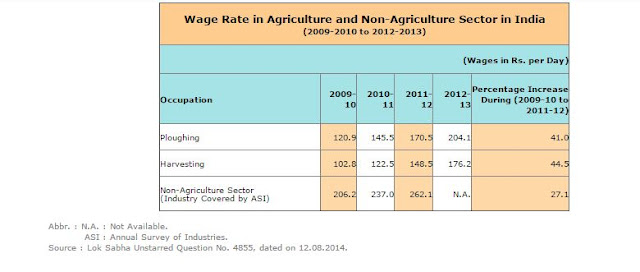National Family Health Survey-5 the state level data: Let’s play with some indices: Part 1
NFHS-5 data at the state level is now available for all states. Taking various ideas and indices altogether, let’s talk in the more easy way, who progressed and who didn’t.
Whenever one talks about development, the first index that comes to
mind is Human Development Index. The human development index has three main indicators:
health (Life expectancy index), education (expected years of schooling and mean
years of schooling), and income (per capita gross national income (PPP)). This covers the main important pillars. While the Human development index measures development,
there are other indices like the multi-dimensional poverty index which measures poverty. Global Multidimensional Poverty Index, given by Oxford Poverty and Human
Development Initiative, has 10 indicators. Table no.1 gives more details.
Table no.1
While Human Development Index can easily be constructed at the state level, the multidimensional poverty index is difficult to construct at the state level. The indicator values in MPI is constructed for household and then
if it is more than a threshold level then a household can be identified as a poor
household. And then a total number of poor households are calculated and then
state-level analysis can be done. But since household level NFHS data is still
not available, in this article, I am trying to adjust these indices to
construct an index at the state level.
I am trying to incorporate all indicators from MPI and HDI:
1)
Life expectancy rate
2)
Expected years of schooling
3)
Mean years of schooling
4)
Per capita Gross National Income (PPP)
5)
Malnutrition (Children under 5 years who are
severely wasted (weight-for-height))
6)
Child mortality (Under-five mortality rate
(U5MR))
7)
Cooking (Households using clean fuel for cooking)
8)
Sanitation (Population living in households that
use an improved sanitation facility)
9)
Drinking water (Households using clean fuel for
cooking)
Electricity
(Population living in households with electricity)
In the above 10 indicators, the direction of Malnutrition and
Child mortality is opposite. In other words, having a higher number of child
mortality represents backwardness or a low level of development. Same for malnourishment.
Therefore, we have to change them in a positive direction. Under-five mortality
rate (U5MR) is per 1000 while Children under 5 years who are severely wasted
(weight-for-height) is in percentage. Therefore, the Under-five mortality rate
(U5MR) can be subtracted from 1000, and Children under 5 years who are severely
wasted (weight-for-height) can be subtracted from 100.
Nourished children= 100- Malnourished Children
Child Survival = 1000 - Child mortality (Under-five
mortality rate (U5MR))
Normalization is done by using the following steps:
Where x: life expectancy rate, Nourished Children, Cooking,
Sanitation, Drinking water, Electricity (as 100 can be a maximum value which can
be achieved)
Where y: Child Survival (as 1000 can be the maximum value which
can be achieved)
Where z: Expected years of schooling, mean years of
schooling, per capita GNI.
After normalizing, weights are assigned to each indicator.
As we can see in table 1, different weights are assigned. I am trying to keep
these weights the same. Therefore, to keep these weights unchanged, 1/16 weightage
should be assigned to cooking, electricity, sanitation, water, and 2/16 weightage
should be assigned to life expectancy, survival, nourished children, mean years
of schooling, expected years of schooling, per capita GNI.
Therefore, a newly formed index will be
1/16*(Indicatorcooking + Indicatorelectricity
+ Indicatorsanitation + Indicatorwater) + 2/16*(Indicatorper
capita GNI + Indicatormean years of schooling + Indicatorlife
expectancy + Indicatorexpected years of schooling+ Indicatorsurvival
+ Indicatornourished children)
The data for mean years of schooling, expected years of
schooling, per capita GNI, life expectancy is extracted from the global data lab (https://globaldatalab.org/). The data for
other indicators are taken from NFHS data.
Further states are divided into the larger and smallest states. This
categorization is done based on NITI Ayog's categorization (http://social.niti.gov.in/uploads/sample/health_index_report.pdf).
Index Score and Ranking: SS for the Smaller States, LS for the Larger States and UT for Union Territories
Kerala has maintained the rank in 2014 as well as in 2019’s
NFHS time period. Surprisingly, poor
states like Bihar, Jharkhand, and Uttar Pradesh and rich states like Gujarat and
Maharashtra have seen a decline in this development index score. Although
comparing the index score might be a problem as in normalization of Expected
years of schooling, mean years of schooling, per capita GNI, the maximum and
minimum values from the given sample. Therefore the decline in the score might
happen due to changes in minimum and maximum values. But even after fixing the minimum
and maximum values, these states have witnessed a fall in index scores. Gujarat
and Maharashtra have also seen a decline in index ranking. Why these rich
states are witnessing a fall in the index score and ranking? This decline comes
from one indicator i.e. malnutrition. These states have witnessed an increase
in malnutrition.
Figure no.1 highlights some interesting points.
This is a scatterplot between per capita GNI (PPP) in 1000
US dollars.
Yellow dots are for the 2019 year. We can see easily that yellows
dots are right and below of blue dots. This suggests that in terms of income,
states are moving ahead but in terms of malnutrition, states are not doing well.
(I have just taken one indicator for malnutrition i.e. Children
under 5 years who are severely wasted (weight-for-height), if we take stunted
then the development index score will go down further as states are doing very
bad as far as malnutrition in terms of children who are stunted.).









.jpeg)

टिप्पण्या
टिप्पणी पोस्ट करा